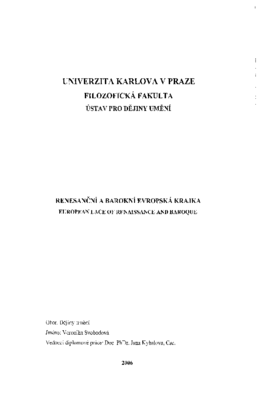Renesanční a barokní evropská krajka
European lace of renaissance and baroque
diploma thesis (DEFENDED)

View/
Permanent link
http://hdl.handle.net/20.500.11956/7207Identifiers
Study Information System: 26946
Collections
- Kvalifikační práce [23977]
Author
Advisor
Referee
Jarošová, Helena
Faculty / Institute
Faculty of Arts
Discipline
History of Art
Department
Institute of Art History
Date of defense
14. 9. 2006
Publisher
Univerzita Karlova, Filozofická fakultaLanguage
Czech
Grade
Very good
Tato pnice se pokusila nacrtnout dulezite a zajimave aspekty vyvoje evropske krajky a jeji ulohu ve spolecnosti. Krajka je definovami svoji vzdusnosti, prolamovanosti a bohatosti vzoru. Mezi prave krajky se fadi krajka sita a palickovana. Obe techniky se vyvinuly zfejme behem prvni poloviny 16. stoleti soucasne v Italii a ve Flandrech. Sita krajka vznika sitim ozdobnych stehu jehlou na pomocnych konturach z niti napnutych na pergamenu. Palickovana krajka se vytvari kfizenym a kroucenim pfizi navinutych na palickach. Je upevnena spendliky na podusce, na ktere je umisten podvinek s vypichanym vzorem. Palickovana krajka se dale deli na krajku mnohoparovou a stfihanou. Sita krajka se vyvinula z prolamovane vYsivky. Jejim nejblizsim pfedstupnem jsou techniky point coupe a reticella. Bohate vzorovanou reticellu muzeme spatfit na mnozstvi dobovych portretu. Palickvana krajka se vyvinula z pozamenterie, z propletanych prymku. Prvni krajky, vychazejici z prolamovanych vYsivek, mely geometricky dekor odvisly z pravouhlosti osnovy a utku tkaniny. Geometricky vzor napodobovala i krajka palickovana. Ve druhe ctvrtine 17. stoleti se dekor meni na linearni a rostlinny. Ve druhe polovine 17. stoleti jsou m6dni velke kvetinove motivy. Ve stoleti 18. jsou krajky jemne a lehke, v prvni polovine 18. stoleti vypliiuje bohaty...
Lace is a decorative ajour textile. Real laces can be divided into needle laces and bobbin laces. There are two types of bobbin laces: straight and part-lace. These both techniques were developed in the epoch of renaissance, in the first half of the 16th century. The needle lace was developed from a cutwork. The immediate precursors of the needle lace were "point coupe" and "reticella" techniques. The bobbin lace was developed from a passementerie. The bobbin laces as well as the needle laces appeared probably at once in Italy and Flanders. The first laces have a geometric decor. Linear or plant decors were used in the first half of the 17th century. Fine and light laces with a flower motif rise in the 18th century. In the end of the 18th century, the motifs are very small and the most of the laces fill mesh ground. In the epoch of the renaissance and the baroque, good conditions for complex figurative scenes were allowed. A grateful space for (riche -great) religion scenes was given. The lay scenes, almost genre, symbolic and hunting scenes can be seen on the lace, too. All the 16th century and in the first half of the 17th century appeared a lot of Pattern Books first for needle laces and then for bobbin laces in Germany and Italy. It is a proof (evidence) of a great vogue of the lace.
